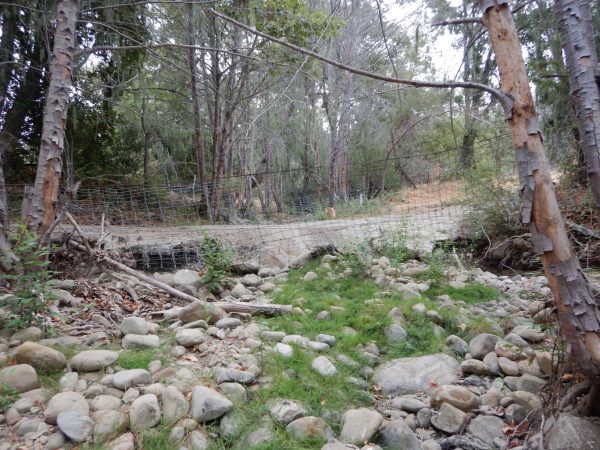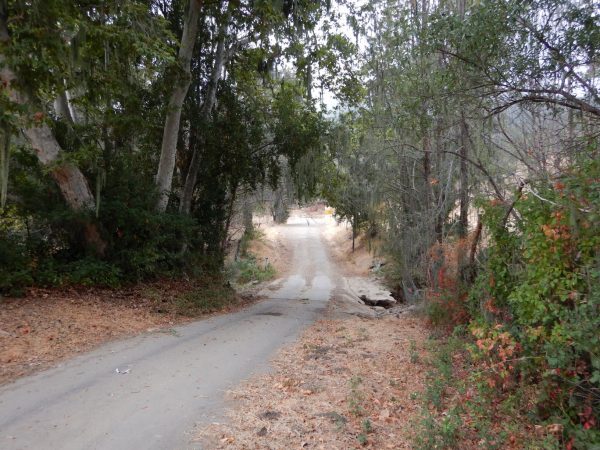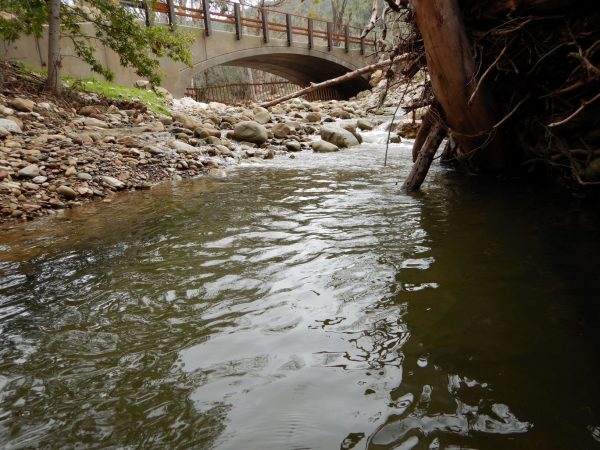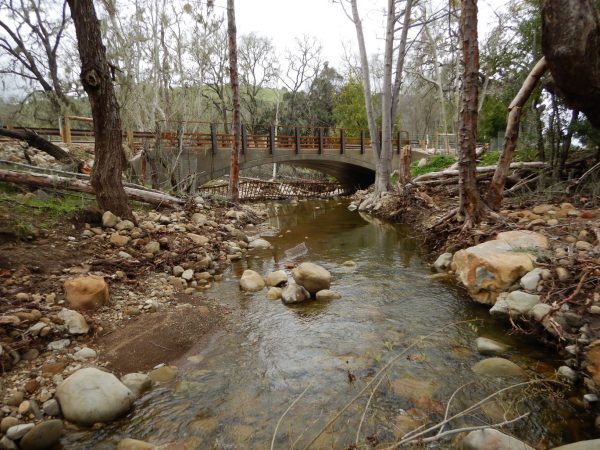About this project
The problem
A concrete low flow Arizona type crossing of S. Refugio Road over Quiota Creek impeded upstream and downstream migration for the endangered southern California steelhead that are known to inhabit the stream. The barrier needed to be removed to allow for fish passage and to improve road safety.
The solution
Restoration project activities included:
- Removing a concrete low-flow Arizona crossing
- Installing a new prefabricated Contech 60 foot bottomless-arched culvert that fully spans the creek
- Grading the resulting creek bed to improve fish passage conditions for both juveniles and adults
- To provide a more natural channel bed gradient under the bridge, placing rock weirs and a roughened channel to create hydraulic diversity and maintain channel stability
- Adding vegetated rock slope protection upstream and downstream to prevent and/or limit scour
- All areas disturbed by construction activities were revegetated with rock slope protection upstream and downstream to prevent and/or limit scour.
- All revegetation was done using locally native plant cuttings and hydroseed.
Project design and engineering were done by HDR Fisheries Design Center.
Project benefits
The Project provides a net benefit to endangered southern California steelhead by re-opening access to 2.73 miles of spawning and rearing habitat within the creek. It also improved riparian cover and creek functionality, eliminating migration delays and opening spawning. The installed instream and bank elements have created habitat for rearing, over-summering refuge, and spawning areas in the upper section of Quiota Creek, a NOAA-NMFS designated critical habitat for the recovery of endangered southern California steelhead. The project allows terrestrial species such as the California red-legged frog the option to cross underneath the new bridge and avoid being potentially killed or injured by vehicles traveling on South Refugio Rd.
The new bridge improved road safety to Santa Barbara County standards for vehicles of all sizes, pedestrians, and cyclists by providing an all-season road with guardrails, bridge bike rails, and road berm vegetation as well as visual improvements, including a graffiti-proof brown paint treatment to all exposed concrete elements of the bridge.
Project context and Story Map of Quiota Creek fish passage improvement projects
On behalf of the U.S. Bureau of Reclamation, Cachuma Operations and Maintenance Board (COMB) is responsible for implementing the 2000 Cachuma Project Biological Opinion, which requires monitoring of the southern California steelhead population downstream of Lake Cachuma, monitoring water quality conditions in the lower river and its tributaries, and implementing stream and fish habitat restoration projects.
These stream enhancement projects are mostly funded by state and federal grants and are implemented by COMB. The first project was successfully completed in 2000 with 17 additional projects completed since then (the most recent in December of 2019). COMB has used the Habitat Restoration and Enhancement Act (HREA) for Quiota Creek Crossing projects 3, 4, 5, 8, and 9, and received Fisheries Restoration Grant Program (FRGP) funding for Quiota Creek Crossing projects 0A, 1, 2, 3, 4, 5, 7, 8, and 9. HREA was not in place until 2015, after some of these projects had been implemented.
A summary of the effort and a brief description of each of these projects can be seen through a Story Map that allows interactive browsing from a complete watershed view to specific projects including designs, construction details, funding, etc.
Proponent
Cachuma Operations and Maintenance Board (COMB)
Status
Completed in 2018
Type of project
- Improvements to stream crossing and fish passage
- Stream and riparian habitat and upslope watershed sites
County or Counties
- Santa Barbara
Watershed
Quiota Creek
Project size
Under 5 acres/500 total linear feet




